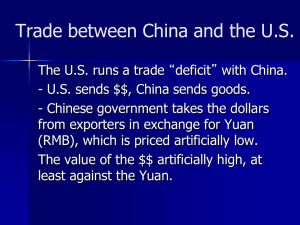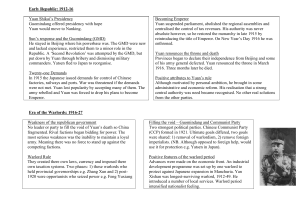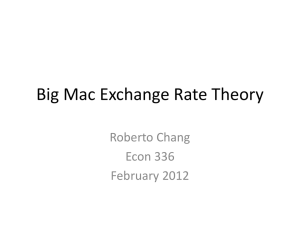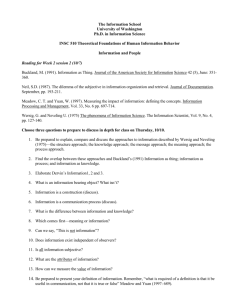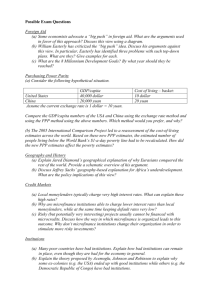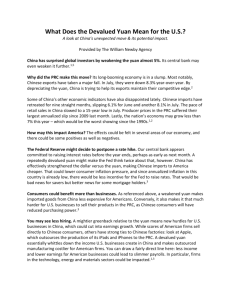How did Yuan Shikai betray the Republic?
advertisement
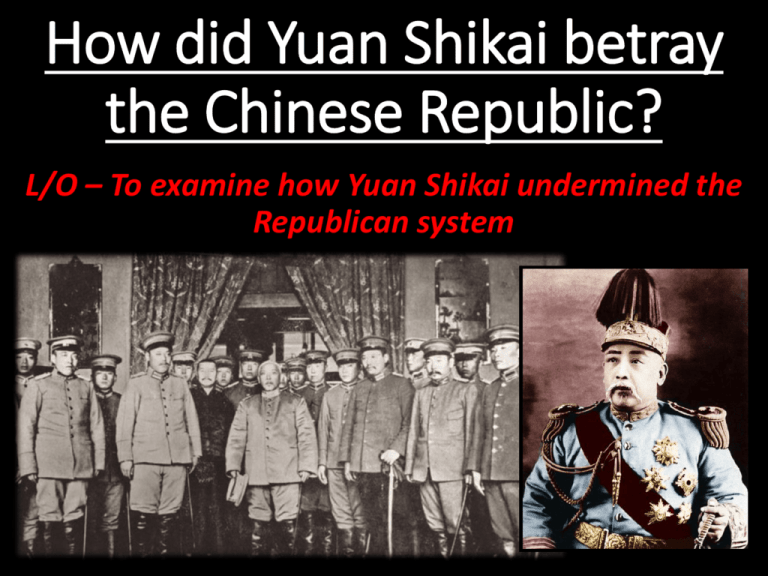
How did Yuan Shikai betray the Chinese Republic? L/O – To examine how Yuan Shikai undermined the Republican system Yuan Shikai (1859-1916) • Yuan Shikai was a leading Qing general who is famous for single-handedly bringing about the end of the Qing Dynasty. • In 1912 he became President of the new Republic of China. However he also betrayed the Republic, destroyed the Parliament and Constitution and even attempted to have himself crowned emperor! • With his death in 1916, he left behind a weak government and a divided China, ruled by competing groups of warlords. It would take until 1927 before China would be united again. Early Career • Yuan was a protégé of the Qing reformer, Li Hongzhang. He was an able military leader and commanded troops from 1884. • From 1885-1894 he was appointed as China’s top official in Korea, working to influence King Kojong. After the SinoJapanese War, he was entrusted by Cixi to lead the first ‘New Army’ – a modern fighting force. • This ‘Beiyang Army’ was well-trained, disciplined and well-equipped. The Qing Dynasty was reliant on Yuan and his armies, placing him in a very powerful position in Court politics. Early Career • During the 1898 ‘Hundred Day Reforms’, Yuan sided with Cixi and worked to suppress the reforms, betraying Emperor Guangxu. • However during the Boxer Rebellion, Yuan refused to use his Beiyang Army to attack the foreigners. After the rebellion he was appointed Governor of Zhili and gained other government posts. • By 1911, Yuan Shikai was one of the most powerful officials in China. But would he support the revolution? And could he be trusted? Role in the Revolution • After the 10/10 Revolution in Wuchang in 1911, the Qing Court begged Yuan Shikai to lead the attack on the revolutionaries. • They offered to appoint him as GovernorGeneral of Hubei and Hunan provinces. Sensing his key position, he refused! Instead, he demanded: 1. 2. 3. 4. 5. 6. Inauguration of a National Assembly; Organisation of a ‘responsible cabinet’; Pardon for the Revolutionaries; Lifting the ban on parties; Full power over the armed forces; Guarantee of military funds. Role in the Revolution • Prince Chun (the regent) had no choice but to agree and appointed him Imperial Commissioner in full charge of the Army and Navy. He still refused! • On 1st November, the Court made Yuan Premier, finally coming out of retirement. At this point, Yuan began negotiating with the Revolutionaries as well. • However talks broke off when Sun Yatsen was elected by the revolutionaries as ‘Provisional President’ on 29th December 1911. Role in the Revolution • In Jan 1912, he declared to Sun that he would force the abdication of the Court if the presidency was offered to him. • Sun Yat-sen had no choice but to agree. Yuan controlled the most powerful armies in China. On 12th February 1912, the abdication of the Imperial Court was announced. • On 13th February, Sun resigned as provisional president. On 14th Feb, the provisional parliament elected Yuan as provisional president. Role in the Revolution • On his inauguration on 10th March 1912, Yuan Shikai promised to uphold the provisional constitution and the new Republic. • Sun Yat-sen was disappointed. His ‘three principles of the people’ had been neglected. People were anxious to compromise with Yuan to achieve peace. Sun was seen as an impractical idealist. • Nationalism had been achieved yet many failed to see the need for ‘democratic reconstruction’ or building the ‘people’s livelihood’. Yuan’s Betrayal of the Republic • On becoming provisional president, Yuan began to consolidate his power, dissolving the new republic and even attempting to establish a new dynasty. This proceeded in three stages: • Stage 1 – Yuan began consolidating his position by appointing supporters and outmanoeuvring the revolutionaries. • Stage 2 – Moved to dissolve the structures of the republican government including the parliament and constitution. • Stage 3 – Having created a virtual dictatorship, Yuan attempted to crown himself as emperor. Stage 1: Establishing his Power • In his new provisional ‘cabinet’, Yuan gave the important jobs like foreign Affairs & war to his henchmen. • Next, Yuan forcibly disbanded Tongmenhui troops in Nanjing without the Premier’s countersignature, required by the Constitution. • On 16th June 1912, Premier T’ang Shao-i resigned in protest along with the four Tongmenhui cabinet ministers. • He appointed his friend, Chao Ping-Chun, as premier on 24th Sep 1912. He now had control over the executive branch of government. Stage 1: Establishing his Power • In December 1912, elections for the new parliament were won by the newly formed ‘Kuomintang’ (Nationalist Party). The KMT was led by Sun Yat-sen and formed by the merger of the Tongmenhui and four other parties. • It won 269/596 seats in the lower house and 123/274 in the upper house. This meant its popular leader, Sung Chiao-jen, would become the new premier. • However on 20th March 1913, Sung was assassinated at Shanghai railway station on his way to take up the post! Yuan was blamed but the assassin mysterious died in prison. Stage 1: Establishing his Power • By early 1913, it was clear that Yuan Shikai was trying to usurp power. A divide was growing between Yuan and the revolutionaries. • In April 1913, Yuan negotiated a foreign loan of $25 million without the approval of Parliament. In return, Parliament impeached the government. Yuan responded by dismissing KMT military governors throughout southern China. • On 12th July 1913, Kiangsi and six other provinces then declared independence and a ‘second revolution’. It was quickly crushed by Yuan, whose warlords took control of these provinces. Stage 2: Destroying the Republic • With his power secure as provisional president, Yuan now worked to destroy the Republican system. • On 5th October 1913, he urged parliament to rush through presidential elections, issuing a Presidential Election Law. The Constitution had not even been promulgated yet! • The vote the next day was disrupted by Yuan’s troops in disguise who yelled, ‘If you do not elect the president we want, do not expect to leave.’ Stage 2: Destroying the Republic • Despite this, it took three votes in parliament to elect Yuan, who was formally inaugurated as President on 10th October 1913. • In response, parliament tried to promulgate the Tientan Constitution on 31st October. This attempted to strip away power from the presidency by creating a cabinet-style government. Yuan was incensed! • Yuan now sought to destroy parliament. On 4th November he dissolved the KMT, revoking the credentials of 358 MPs. By January 1914, the National Assembly couldn’t operate due to a lack of parliamentarians so he dissolved it! Stage 2: Destroying the Republic • Yuan had now formed a virtual dictatorship. He now sought to extend his tenure as President. He called a national conference to revise the 1912 provisional constitution. • The result was a new ‘constitution compact’ promulgated on 1st May 1914. It extended the presidential term to ten years, renewable by re-election without limit! • The president also had the right to nominate a successor. He now had the power of an emperor but without title! Stage 3: Becoming Emperor • Yuan’s ambitions didn’t stop there. By 1915, he was prepared to create a new dynasty. • First he tried to gain foreign support by agreeing to the Japanese ’21-Demands’ in January 1915. This extended Japanese control of the economy. People protested yet he pressed ahead regardless. • On 21st August, a ‘Peace-Planning Society’ was created to organise support for Yuan as emperor. The 21-Demands – January 1915 Group 1 – Japan to have control of Shandong Province and its economy Group 2 – Japan to be given economic influence over Manchuria and East Mongolia, including all railways and the city of Port Arthur (Lushan). Group 3 – Japan to be given control over the Hanyeping Mining Complex Group 4 – China is not permitted to cede land to any foreign power apart from Japan Group 5 – Japan to be given influence over all important political, military and financial decisions, Japanese workers to be employed in the Chinese Police Force Stage 3: Becoming Emperor • On 20th November, the National People’s Representative Assembly voted for monarchy. Representatives of the provinces also began ‘petitioning’ Yuan to be emperor. • On 12th December, Yuan finally agreed to their demands. The following day, he decreed that 1916 would be the start of his new reign as the ‘Hongxian’ emperor. • His reign would be called the ‘Glorious Constitution’ or Hung-hsien. Stage 3: Becoming Emperor • However Yuan had overestimated his support. Even his close supporters and generals were disgusted by his attempt to bring back monarchy. • The provinces began to rebel. A ‘National Protection Army’ was formed in Yunnan to fight Yuan, led by Liang Ch’i-ch’ao. Yunnan declared independence on 25th December. • Other southern provinces and warlords followed and Yuan was forced to delay his enthronement scheduled for 1st January 1916. Final Defeat • Under intense pressure, Yuan was forced to give up his attempt to become emperor on 22nd March 1916. • This wasn’t enough for many provinces. By May 1916, Yunnan, Kweichow, Kwangsi, Kwanghung, Chekiang, Shensi, Szechwan and Hunan had all declared independence. Even Japan declared supported for both north and south China. • On 1st August 1916, Yuan suddenly died, aged 56 of uremia. He had been deserted by his closest followers and shamed in the eyes of the people. Reasons for the failure of Yuan Shikai 1. Provincialism of the Gentry - Local gentry feared that a restored monarchy would successful centralise power again, harming their own interests and independence. 2. Military Followers – Yuan’s generals made use of him to gain power for themselves in their local areas. Restoring the monarchy threatened their newly won power. 3. Strength of Republicanism – The idea of a republic had become embedded amongst intellectuals. Restoring the monarchy was seen as a backward step. 4. 21-Demands – By accepting the 21-Demands, Yuan’s popularity and credibility was serious damaged. Legacy of Yuan’s Rule 1. After Yuan’s death, the old parliament was re-established in August 1916, and the original 1912 constitution was followed again. 2. Some intellectuals became disillusioned with republicanism and monarchy, turning to new ideas like communism. 3. However Yuan had significantly weakened the power of the central government. China was divided. His old generals who he relied upon to rule, began to dominate the provinces, ignoring Beijing. This led to the warlord period until 1927. 4. Social and economic reforms had been neglected by Yuan, which weakened China and encouraged more aggressive demands from Japan. Paper 3 - Exam Question 1 (2011) • In what ways, and with what consequences, did Yuan Shikai betray the 1912 Chinese Republic? (20 marks) This question covers the early period of the Chinese Republic following its establishment in 1912 after the 1911 “Double Ten” Nationalist Revolution and also the legacy left by Yuan Shikai (Yuan Shih-k’ai) after his death in 1916. Politically, the Nationalist Revolution and the new Chinese Republic were hijacked by Yuan Shikai (Yuan Shih-k’ai). Candidates may examine the career of Yuan Shikai (Yuan Shih-k’ai): his betrayal of Guangxu (Kuang-hsu) in the Hundred Days Reform; his allegiances during the Boxer Rebellion; why he supported the 1911 Nationalist Revolution; the reasons why Sun Yixian (Sun Yat-sen) gave the presidency of the Chinese Republic to him in 1912. Yuan’s actions showed that he had no loyalty to either the Qing (Ch’ing) or the new Republic. Problems that beset his government include: the creation of the Guomindang (Kuomintang) which won a landslide election in 1913; when Yuan borrowed money from foreign sources the National Assembly attempted to impeach him; he crushed the opposition violently; and party politics failed. In November 1913 Yuan outlawed the Guomindang (Kuomintang) and Sun had to flee the country. In 1914 he dissolved the National Assembly and provincial assemblies and created a Council of State and he became a dictator. Yuan tried to make himself Emperor in 1915, but was thwarted by his own army officers and unrest in various provinces. By the time he died in 1916 the power of the central government had been seriously weakened. His example undoubtedly encouraged other military commanders to use their armies to establish control over whatever regions they could and between 1917 and 1927 warlordism spread throughout China. Other factors that may also be mentioned include: the way Yuan’s government gave in to Japan’s 21 Demands in 1915; after his death the humiliation for China of the Treaty of Versailles in 1919 and the political and social unrest that followed. If only “ways” or “consequences” are addressed, mark out of a maximum of [12 marks]. Paper 3 - Exam Question 2 (2007) • In what ways, and to what extent, was Yuan Shikai responsible for the rise of warlordism in China in the twentieth century? (20 marks) Candidates will need to define “warlordism” and to recognise that its roots may be traced to the decline of the authority of the Qing (Ch’ing) central government and the rise of provincial leaders in the second half of the nineteenth century. Yuan Shikai was himself a protégé of Li Hongzhang (Li Hung-chang), who had remained governor-general of Chihli province for 25 years. Yuan’s actions during 1911–1916 showed that he had no loyalty to either the Qing or the new Republic. Yuan failed to become emperor, but his example undoubtedly encouraged other military commanders to use their armies to establish control over whatever regions they could and then to expand if possible to control all China. [0 to 7 marks] for an account of Yuan’s career. [8 to 10 marks] for awareness of the connection between Yuan and warlordism. [11 to 13 marks] for a simple analysis of warlordism that draws parallels between Yuan and later warlords and recognises that the antecedents of warlordism lay in the nineteenth century. [14 to 16 marks] for a more detailed and balanced analysis of warlordism, its causes and precedents and Yuan’s role in its twentieth century development. [17+ marks] for a well-balanced, detailed and sophisticated analysis.

